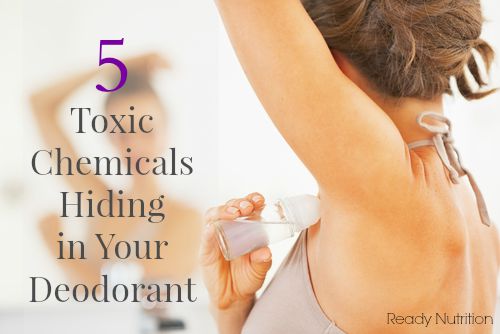
According to the National Cancer Society, “Reports have suggested that these products contain harmful substances, which can be absorbed through the skin or enter the body through nicks caused by shaving. Some scientists have also proposed that certain ingredients in underarm antiperspirants or deodorants may be related to breast cancer because they are applied frequently to an area next to the breast.”
Since our skin is our largest organ, we need to take measures to ensure that what we put on it is as natural as possible. Here are five harmful chemicals found in deodorant that can play a part in the diminishment of our health.
1. Aluminum Compounds
Aluminum compounds are added to deodorant to block the pores from sweating. Aluminum, like other heavy metals, may interfere with the ability of estrogen receptors to correctly process the hormone and are linked to breast cancer in women, prostate cancer in men, and an increased risk of Alzheimer’s.
2. Parabens
Parabens are preservatives used in some deodorants and antiperspirants that have been shown to mimic the activity of estrogen in the body’s cells. This chemical disrupts hormonal balances and can lead to early puberty in children and hormone-related cancers in women and organ toxicity. The belief that parabens build up in breast tissue was supported by a 2004 study, which found parabens in 18 of 20 samples of tissue from human breast tumors.
3. Propylene glycol
When this chemical is paired with other chemical additives, it can be extremely dangerous. This ingredient causes damage to the central nervous system, liver and heart. Even in small concentrations (2 percent or less), propylene glycol provokes skin irritation in those with sensitive skin. Moreover, some manufacturers have made deodorants with 50 percent propylene glycol content. Believe it or not, you’re likely to find this in many “natural” deodorants.
4. Triclosan
Triclosan is classified as a pesticide according to the FDA. Although the FDA uses are not regulated under pesticide law, EPA considered these exposures in the aggregate risk assessment. In deodorants, triclosan is used as an antibacterial agent and preservative, and reacts with tap water to create chloroform gas, a potential carcinogen. This chemical can also possess endocrine disrupting properties that has shown up in human breast milk and blood.
5. Steareths
Usually listed with a number (like steareth-15), these additives come from a cheap process that makes harsh ingredients more mild. The process (known as ethoxylation) produces carcinogenic 1,4-dioxanes during manufacturing.
Natural Alternatives
Rather than allowing chemicals and toxins to absorb into the skin, learn about the natural alternatives that are out there.
Mineral salts with active ingredients, such as ammonium or potassium alum work by constricting the protein in sweat so that bacteria have less to feed on. Clay minerals, such as bentonite, and natural powders like cornstarch or arrowroot help absorb moisture. Essential oils working in conjunction with natural astringents (witch hazel, alcohol, etc.) have also been shown to help evaporate moisture on the skin and constrict pores. Another alternative is to make your own deodorant.
Quick Deodorant
- 1/4 cup baking soda
- 1/4 cup corn starch (If you have especially sensitive skin, increase the amount of cornstarch to 6 tablespoons and decrease the baking soda to 2 tablespoons)
- 10 drops of scented oil (tea tree oil, lavender, rose, etc.)
- 2 tablespoons coconut oil
- Put 1/4 cup each of baking soda and cornstarch in a bowl and add 10+ drops of scented oil (you can add more if you would like).
- Stir 2+ tbsp of coconut oil until it is the consistency you like.
- Smash the mixture into an empty deodorant container.
- Let it set a few days and enjoy.
Note: This deodorant should be applied lightly. It is invisible, but works. Read about other recipes for everyday products.
Further, using a warm washcloth and scrubbing your arm pits will help to remove any bacteria and help open up the pores so they begin functioning again. While doing this, you can add a drop or two of essential oils such as tea tree oil, to help cleanse the area more thoroughly.
As you can see, there are alternatives to chemical-laden deodorants. It is important to inform yourself on the risks of these over-the-counter antiperspirants and begin considering the alternatives. They are more natural, cheaper, less harmful and will keep your body functioning rather than backing it up.

If you eat a balanced and healthy diet you should not need deodorant. NO?.